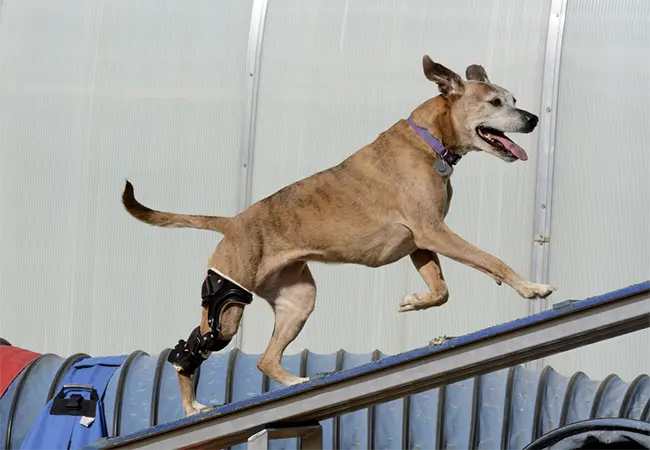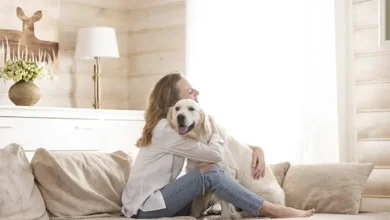
As our furry companions age, it becomes more important than ever to keep them active and healthy. Just like humans, dogs can experience a decline in physical and mental health as they grow older. However, regular exercise can help prevent and manage a variety of age-related issues in senior dogs. In this article, we’ll explore five key reasons why it’s crucial to keep your older dog moving and engaged.
1. Maintaining Mobility And Joint Health
As dogs age, they may experience a decline in mobility and strength. This can be due to various factors such as osteoarthritis, muscle weakness, or reduced appetite. Regular exercise can benefit senior dogs by improving their mobility and overall quality of life.
Age-appropriate exercises such as “bicycling” the hind legs and stretching are great for enhancing joint flexibility and gait. It also allows senior dogs to engage in moderate physical activity without overexerting themselves. Additionally, owners should monitor middle-aged to senior dogs for early signs of arthritis, which commonly affects older pets.
Physical therapy is another excellent way to improve mobility and diminish discomfort for aging canines. Dog owners should feed their furry friends diets that contain natural glucosamine to support joint health but must remember not to let pets become overweight as it stresses joints even more.
Lastly, if a dog is diagnosed with arthritis, adjustments need to be made in terms of exercise routines while still keeping them active with regular stretching sessions that help alleviate any stiffness they may have acquired throughout the years.
2. Preventing Obesity And Related Health Issues
As dogs age, they become less active and their metabolism slows down, which can lead to weight gain and related health issues. It’s important to prevent obesity in older dogs as it can lead to serious health problems such as difficulty breathing, exercising, skin and coat problems, and an increased risk of cancers. Losing 5% to 10% of body weight has meaningful health benefits for dogs. You can see more health related articles at olderdogcare.com
Maintaining a healthy weight: A structured feeding plan contributes to maintaining a healthy weight while daily exercise helps burn calories. this also Improves cardiovascular health: Exercise stimulates the heart muscle leading to improved cardiovascular function.
It can be qiute easy for your senior dog to gain weight as the age and become less active so exercise will help them stay trim and healthy.
3. Improving Cognitive Function And Mental Stimulation
As dogs age, they may develop cognitive dysfunction syndrome (CDS), a common age-related disease that affects their brain. Similar to Alzheimer’s in humans, dogs accumulate deposits of beta-amyloid in the brain with age. However, regular exercise can benefit a senior dog’s brain through physical and mental stimulation. It’s important to note that physical exercise helps keep a dog’s body healthy and can actually grow brain cells.
Dietary sources of antioxidants and specific types of fats can also enhance cognitive ability in older dogs. Providing healthy food for your senior dog will make sure they are receiving the necessary nutrients for optimal health. Additionally, cognitive enrichment, environmental enrichment, and extra programmed exercise can help reduce cognitive decay in aging dogs.
Studies have shown that physical exercise is a strong gene modulator that induces structural and functional changes in the brain which helps determine enormous benefits on both cognitive functioning and wellbeing. Exercise provides dogs with mental challenges as well as helping them stay physically fit, which makes it beneficial for their overall health. Incorporating a routine exercise program into your dog’s lifestyle will not only keep them active but also reduce anxiety levels by releasing feel-good hormones called endorphins.
4. Strengthening The Immune System
As dogs age, their immune systems become weaker and more susceptible to illnesses. Exercise is one way to help strengthen their immune system and improve overall health. Regular exercise can burn fat, counteract inflammation, and boost immunity in dogs.
In addition to exercise, feeding a quality diet is crucial for immune function in dogs. A well-balanced diet with the necessary nutrients can help keep the immune system functioning properly.
Moderate intensity exercise for up to 45 minutes is beneficial for immune defense, particularly in older adults and people with chronic diseases. The same applies to older dogs as well – moderate exercise has been shown to improve the function of their innate and adaptive immune systems.
Swimming is also a low-impact activity that can decrease stress on an old dog’s body while increasing fun. Water resistance during swimming provides an excellent workout without putting unnecessary stress on joints.
Consulting with a veterinarian before starting any exercise program for your dog is essential. They can provide valuable guidance on what exercises are appropriate based on your dog’s age, breed, weight, and current health status.
5. Incorporating Low-impact Exercises For Senior Dogs
As dogs age, it’s important to maintain their physical and mental health through exercise. However, high-impact activities can put unnecessary stress on a senior dog’s body. That’s where low-impact exercises come in.
Low-impact exercises are a great way to keep senior dogs active without causing strain on their joints and muscles. Leisurely walks and swimming are two great examples of low-impact exercises that can benefit older dogs. Additionally, these activities provide mental stimulation which is an important aspect of maintaining overall health in senior pets.
It’s important to note that exercise routine for senior dogs should only involve low-impact activities. As with humans, the physical ability of older dogs changes over time and may require adjustments in their routine. To add some variety to your dog’s routine while keeping things low-impact and safe you can try alternate day walking or mix up places during walks for novelty so it doesn’t get stale.
Incorporating low impact exercises into your senior dog’s daily routine will help improve not only their physical fitness but also their cognitive function. It is essential for maintaining optimal wellbeing as they gradually transition towards late stage life which includes healthy ageing even if it means taking shorter walks more frequently throughout the day rather than a long challenging one walk once per day.The key takeaway here: always consult your veterinarian before starting any new regimen when giving advice on exercise routines, diet changes etc.,“`



